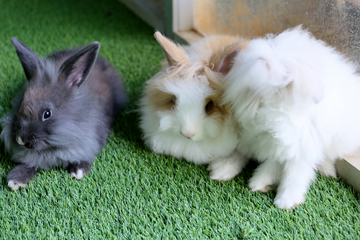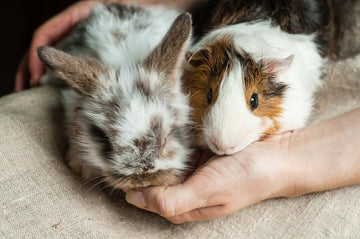Tips on How to Have a Rabbit Becoming Friendly
Rabbits can be incredibly affectionate pets, but they don’t always warm up to people right away. Unlike dogs, who often seek human interaction immediately, rabbits are more cautious. As prey animals, their instincts make them wary of new people and environments. Because of this, it takes time and patience to earn their trust.
Click Here to Shop Rabbit Products.

So, what’s the secret to building a bond with your bunny? The key is understanding their behavior, respecting their boundaries, and using positive interactions to make them feel safe. If you’re wondering how to have a rabbit becoming friendly, this guide will help you create a strong and lasting relationship with your furry friend.

Understanding Your Rabbit’s Natural Instincts
Before you can help your rabbit become friendlier, it’s important to understand why they might be shy or hesitant at first. Rabbits are prey animals, meaning they are naturally cautious and alert. In the wild, their survival depends on their ability to detect and escape danger quickly. While these rabbits are domesticated they still carry these natural instincts.
Why Some Rabbits Are More Cautious Than Others
Not all rabbits react the same way to people. Some may be naturally curious and social, while others take longer to build trust. Several factors influence how friendly a rabbit becomes:
-
Personality: Just like humans, rabbits have unique temperaments. Some are naturally outgoing, while others are more reserved.
-
Past Experiences: If a rabbit has been mishandled or neglected, they may take longer to trust humans.
-
Age: Young rabbits that grow up with gentle human interaction are more likely to be social. Older rabbits who haven't had much contact with people might be more hesitant.
-
Breed: Some rabbit breeds are known to be more social, while others are more independent. For example, Holland Lops and Mini Rex rabbits tend to be affectionate. In contrast, some larger breeds may take longer to bond with their owners.
Creating a Safe and Comfortable Space
One of the most effective ways to make your rabbit feel comfortable is by setting up a safe, quiet space where they can relax. Rabbits are highly sensitive to their environment, and a stressful setting can make them more anxious.
Setting Up the Perfect Rabbit Enclosure
A rabbit’s enclosure should be large enough for them to stretch, hop, and move around comfortably. A small, cramped cage can cause stress and frustration. Instead, opt for a spacious exercise pen or a free-roam setup.
-
Ensure the enclosure is at least 4-6 times the size of your rabbit when they are fully stretched out.
-
Provide a comfortable hiding spot, such as a covered box or tunnel, where they can retreat when they feel overwhelmed.
-
Line the floor with soft bedding or a fleece mat for added comfort.
Allowing Free-Roam Exploration
Rabbits are naturally curious and love to explore their surroundings. Letting your rabbit out of their enclosure for supervised playtime helps them feel more comfortable. Create a rabbit-proofed area where they can safely hop around and interact with you on their terms.
How to Have a Rabbit Becoming Friendly Through Interaction
Once your rabbit feels secure in their environment, you can start building trust through positive interactions. Rabbits respond best to gentle, patient communication.
Let Your Rabbit Come to You
Rather than picking up or chasing your rabbit, allow them to approach you first. Sit or lie down near them and stay still. Let them sniff and explore you at their own pace.
Use Treats as Positive Reinforcement
Hand-feeding your rabbit their favorite treats can help build a positive association with you. Some healthy treat options include:
-
Fresh greens like dill, collard greens, or basil.
-
Small pieces of banana, apple, or carrot (in moderation).
-
Other rabbit safe treats.
If you are unsure what food is safe to feed your rabbit check out our Eating Guide.
Talk to Your Rabbit
Rabbits can recognize voices over time. Speak softly to them when you’re nearby to help them get used to your presence. Over time, they’ll associate your voice with safety and comfort.
Understanding Rabbit Body Language

Rabbits communicate a lot through their body language. Learning how to read their signals can help you understand their comfort level and improve your interactions.
Signs of Trust and Affection
-
Binkying: A happy rabbit will jump and twist in the air—a sign of pure joy!
-
Purring: Soft teeth grinding means your rabbit is relaxed and content.
-
Flopping Over: If your rabbit dramatically flops onto their side, it means they feel completely safe.
Signs Your Rabbit Needs Space
-
Thumping: A loud thump of their hind legs usually means they feel threatened or startled.
-
Running Away: If your rabbit constantly runs from you, they may not be ready for interaction yet.
-
Grunting or Lunging: This is a sign that your rabbit feels defensive and doesn’t want to be touched.
Strengthening Your Bond Over Time

Building a bond with your rabbit takes patience and consistency. Here are some ways to strengthen your relationship:
Establish a Routine
Rabbits thrive on routine. Feed them at the same time every day, offer regular playtime, and interact with them consistently.
Engage in Playtime
Rabbits love playing with toys! Some fun activities include:
-
Providing cardboard boxes or tunnels for hiding and exploring.
-
Giving them safe chew toys to prevent boredom.
-
Setting up a digging box filled with shredded paper or hay.
Grooming as a Bonding Activity
Brushing your rabbit helps keep their coat healthy and can also strengthen your bond. Use a soft-bristled brush and groom them gently. If they enjoy it, they may even start licking you in return—an affectionate gesture among rabbits.
Final Thoughts
Learning how to have a rabbit becoming friendly is a rewarding process that requires patience, understanding, and consistency. By creating a safe environment, respecting their space, and using gentle interactions, you can earn your rabbit’s trust over time.
Once your rabbit sees you as a friend, they’ll start seeking out your company, showing affection, and even following you around the house. With time and care, your rabbit will become a loving and friendly companion.

Fun and Unique Names for Rabbits

Healthy Rabbit Treats for Hoppy Pets





![RHDV2 Critical Information + Frequently Asked Questions [Updated 03/20/2025]](http://www.rabbitholehay.com/cdn/shop/articles/rhdv2-critical-information-frequently-asked-questions-V1.png?v=1742490107&width=360)

